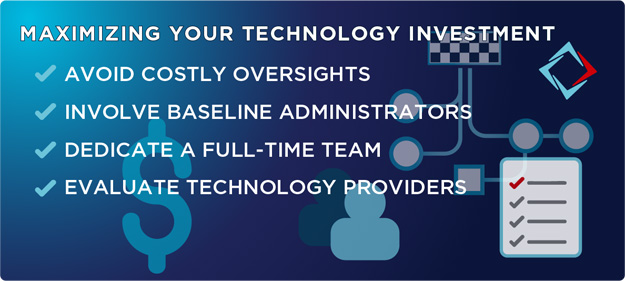
Despite clear signals of a softening economy, equipment leasing and finance companies are continuing to invest in technology. They are deploying innovative technologies to connect more closely with customers, drive operational efficiencies and increase profitability.
However, too many executives overlook a critical beginning step for successful technology selection, implementation and return on investment. That step is this: getting the right people in the organization involved early in the technology planning process. Companies that rely on top-down planning or overly restricted committees always regret it, because minor issues missed pre-implementation can cause big problems afterward.

Avoid Planning Oversights
When key stakeholders are excluded from the early planning process, one of the most serious issues that can surface during implementation is a lack of critical functionality needed by the business. The people who were consulted – often senior executives – weren’t aware of the functionality requirement or deemed it a low priority, and now employees using the technology and responsible for its ultimate success are complaining of its shortcomings.
Fixing the oversight is often possible, but at a cost. Adding unidentified scope after a project goes live has detrimental impacts on the efficiency of the organization and the ROI of the system. Depending on the severity of the missed scope, this can potentially lead to increases in cost or time of up to 20 percent. Ignoring the issue, on the other hand, means leaving a key pain point unresolved with the new system.
Slow buy-in is another problem common to technology implementations where key stakeholders haven’t been involved in the planning process. It is only human nature; employees tend to be slower to learn and adapt new technology when they do not understand its intrinsic value to their jobs and customer relationships.
Involve Baseline Administrators
With these concerns in mind, let’s take a closer look at the types of stakeholders who should be consulted before defining core requirements, setting corporate goals and agreeing on a roadmap for technology implementations.
The most important employees that senior executives should be sure to include in the early planning stages are baseline administrators – from mid-level managers on down to line-level team members. Their actual job titles and departments may vary based on a company’s unique organizational structure.
We at LTi Technology Solutions strongly recommend that companies start by conducting in-depth internal meetings with all mid-level managers to determine each department’s actual involvement in the processes that the technology will potentially address.
The goal of these early planning meetings is to:
- Understand which employees and departments participate in key processes
- Determine where manual processes are still taking place, and why
Armed with these insights, your technology provider will be able to correctly identify inefficiencies in workflow that can be corrected, other processes ripe for improvement and new opportunities that can be captured through enhanced capabilities.
Yes, this level of inclusion may involve lots of employees for some companies, and that’s the reason some businesses skip this important planning step. But think of it like due diligence. You must know exactly where the workflow is slowing down in order to make accurate decisions, prevent time-consuming oversights and maximize ROI later.
And be sure to follow up on early planning meetings with regular internal discussions including baseline administrators. Their ongoing input is vital for a full discovery of critical needs, as it only takes one department or one person to derail progress during implementation.
Dedicate a Full-Time Team
A company embarking on a new technology project should also, whenever possible, designate an internal team to manage the planning and implementation process full time. This paves the way for a faster, and happier, implementation.
Let’s look at the differing experiences of two large financial services businesses we will call “Company A” and “Company B.”
Company A dedicated a team of six people full time to the process from planning through implementation. These team members were no longer doing their “day jobs” but were committed wholly to the technology project. Company A was able to work closely with the technology partners’ team members and go live within seven months of initial decisioning.
Company B designated an internal team of five people. They were devoted to the project full time for the first three months, working closely with the technology partner’s team, but then were told to go back to their regular duties and split their time between the two commitments. Company B took nearly 14 months to go live and is still not fully up-to-speed.
Evaluate Technology Partners
Another key stakeholder to consider when implementing new systems or modules is your technology provider. The decision regarding which technology and which provider to use is an individual choice. But there are some universal considerations to help narrow the selection.
The first consideration is whether the technology provider has a history of supporting the equipment leasing and finance industry in your region. Equipment finance has its own nuances and needs, as do industries in different countries. Companies are best served by technology providers and solutions with proven success in their markets.
Second, insist on integrity. Consult with colleagues in other equipment finance companies to vet the integrity of providers being considered. Ask how the provider has managed not only smooth implementations but also adverse situations. Were their dealings straightforward or evasive?
Third, look for stability. The economic rollercoaster we have experienced in recent years highlights the importance of selecting a technology partner that has weathered many cycles and helped its customers do the same. A provider’s own corporate history also provides clues to stability, for example a history of being bought, sold or merged, especially for purposes of reputation repair, could raise concerns.
Prioritize Technology Planning
“Measure twice, cut once” may be an old adage, but it’s smart to remember this when considering new technology. Thorough planning can help avoid added costs and delays later. One important strategy for ensuring this is to involve baseline administrators early in technology planning, and follow up with them throughout the process to prevent oversights. Secondly, companies that are in a position to do so should dedicate an internal team full time to the planning and implementation process. Also, take the time to vet another important stakeholder in technology transformation – your provider – to ensure they are truly equipped for your success.
Next up: The often-overlooked final step in technology transformation - Watch for Van Wrenn’s article later this month in Equipment Finance Advisor.